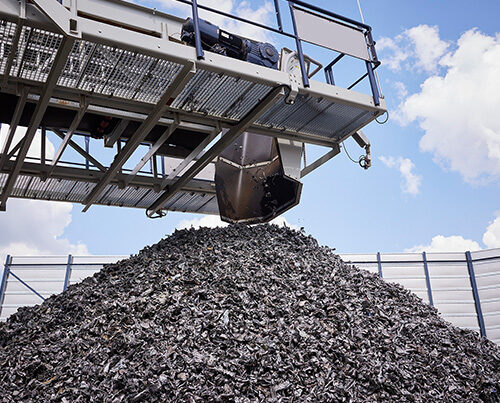This vaping trend and, in particular, the rapid growth in the use of disposable vapes have triggered controversial discussions about the health risks of vaping and the impact this trend is having on the environment. Easy to get hold of and available in a wide range of flavours, these products are particularly popular among young people – fuelling concerns not only about the possible adverse effects they may have on people’s health but also about the way people dispose of their old vapes. The current debates about vaping clearly demonstrate the conflict between consumer trends and environmental protection.
A boom with consequences
Recycling disposable vapes is both complex and expensive as they are made up of a mixture of plastic, metal and batteries. Germany, which imports several million disposable vapes every month in addition to those manufactured in the country, has specific rules and regulations in place like the other EU member states about how electronic devices must be disposed of. Rules and regulations, therefore, that also apply to vapes.
Despite this legislation, many vapes end up in household bins, especially the less expensive disposable ones. Vapes create environmental problems at each and every stage of their life cycle:

Several articles have already appeared about this subject in REMONDIS AKTUELL, for example a piece warning about disposable vapes and another about a possible ban on vapes.
Production:
Large volumes of natural resources are needed to produce vapes; the mining operations required to extract these critical raw materials from the ground damage the environment and cause high levels of greenhouse gas emissions.
Waste:
According to estimates, more than 5 million disposable vapes are consumed in Germany every week, leading to an unnecessary consumption of natural resources.
Dangerous contents:
Incorrectly disposing of devices that contain batteries poses a huge risk to the environment. The substances and materials in these products (such as lithium, cadmium and lead) can cause damage if they are released into the environment as they pollute both soils and waterways.
Fire risk:
Disposable vapes often start fires in bins, refuse collection lorries and waste treatment plants as well as in people’s homes. These fires are not only a risk to people and property, they also cause additional environmental problems.
Recycling disposable vapes is both complex and expensive as they are made up of a mixture of plastic, metal and batteries.


The number of fires is growing
The danger of fires breaking out in the recycling sector is growing all the time as the number of lithium-ion batteries being bought on the battery market and in electrical stores increases. The consequences of people handling such batteries incorrectly and throwing them away into the wrong bin – especially devices containing small batteries like those in vapes – are obvious: fires are breaking out on refuse collection lorries and in sorting and waste treatment plants practically every single day and causing significant material damage.
Almost all types of municipal waste are at risk of such fires – from e-waste, to commercial waste, all the way through to old paper and light packaging materials. Experts expect this problem to get worse over the coming years as an ever greater number of small devices containing lithium-ion batteries are sold on the market.
A ban…
Organisations such as the DUH (Environmental Action Germany), German Medical Association, German Children’s Fund, DKFZ (German Cancer Research Center), NABU (The Nature And Biodiversity Conservation Union) and VKU (Association of Local Utility Companies) as well as the BDE (Federal Association of the German Waste Management Industry) are all calling for disposable vapes to be banned because of their health, fire and environmental risks. In July, the organisations released a joint statement, in which they argued that very little time would be needed to add such a ban to the Electrical and Electronic Equipment Act (ElektroG), which is currently being revised.
…or a deposit?
Rather than banning disposable vapes, a different option could also be implemented via this law: a deposit return scheme, such as the one suggested by Lower Saxony’s Ministry of the Environment last year.
A deposit could also lead to fewer of these products being sold – if the right deposit is charged. The deposit must be high enough so that disposable vapes no longer have a price advantage over reusable vapes. Another effect of such a deposit: both the increased consumption of resources and the increased risks of fire caused by this ever growing trend in disposal vapes would also be significantly reduced.
People have been calling for a deposit to be charged on batteries (installed in devices) with a higher voltage than those in disposable vapes for a number of years now. Industry associations wish to motivate consumers to hand in their old batteries. They believe that an expert report commissioned by the UBA (German Environmental Agency) to assess the introduction of a mandatory deposit for lithium batteries further confirms their point of view.
No matter which option the legislator chooses to take: both the health risks of disposable vapes and the fires caused by them – something that keeps them permanently in the public eye – mean that this topic will continue to be on the agenda. And so: to be continued…
Vapes – particularly popular among young people
To date, the research being carried out to discover the impact of vaping on people’s health is incomplete. Studies have shown that vapes may be less harmful than traditional cigarettes as they do not emit tar or carbon monoxide. However, they still contain nicotine that can have a negative impact on a person’s health and cause e.g. cardiovascular disease and lung damage.
Furthermore, there are concerns about the chemicals contained in vapes and the impact these may have on a person’s respiratory tract. Experts at the BZgA (Federal Centre for Health Education) have, therefore, put out a warning about the dangers of vaping.
According to the BZgA’s 2023 Drug Affinity Study, 17% of 12 to 17-year-olds have tried using a disposable vape – making it the most-tried-out nicotine product among teenagers.
6.7% of teenagers and young adults currently vape using disposable vapes. The World Health Organization (WHO) even recently accused vape manufacturers of using tricks to get children addicted as young as possible. Vapes are being marketed in bright colours and with popular comic action figures, almost like toys. The WHO criticised the fact that among the 16,000 flavours available on the market, companies were also selling chewing gum, candy and vanilla ice cream flavours that were obviously targeted at children.
According to an assessment published by Lower Saxony’s Ministry for Consumer Protection, disposable vapes can be bought in Germany for about seven euros – a much more affordable price for young people than the refillable vapes. Furthermore, they are easy to use and generally do not have a child safety lock even though this is mandatory by law. They can be bought at kiosks, supermarkets and petrol stations – all of them places that are easy for teenagers to get to.
Image credits: image 1: Shutterstock: Vladimir Sukhachev; image 2: Shutterstock: Pixel-Shot












